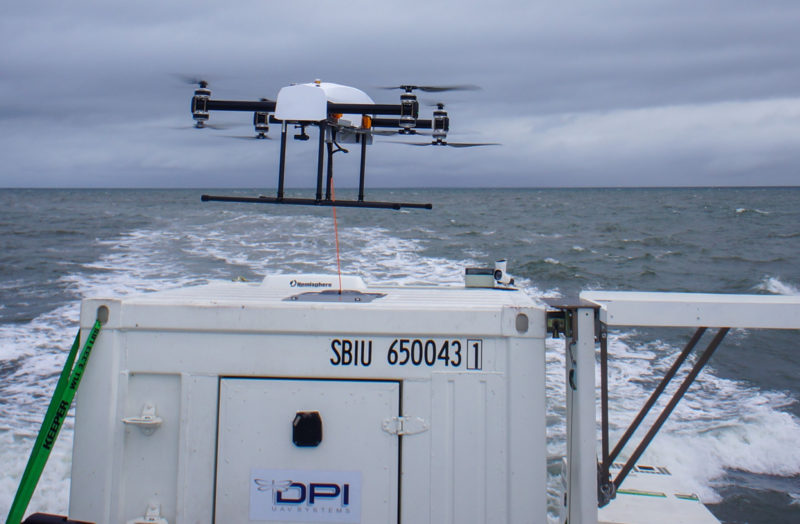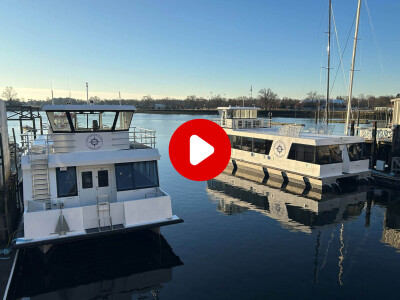One sure way for a vessel owner to increase his operating expenses is to ignore the growth building up on the bottom of his boat. There’s no getting around the fact that a heavily fouled bottom leads to increased fuel expenses.
What’s the best way to monitor that growth so you know when to clean the bottom? Hiring a diver can cost up to $4,000, depending on how big the boat is. In addition, you have to schedule a time for the diver, verify that the water flow is less than one knot, and get authorization from the port authority for the diver.
Another option is SeaDrone, a company in Mountain View, Calif., that started out building underwater drone inspection systems for aquaculture operators but soon realized the shipping industry was a much bigger market for their underwater remotely operated vehicles. One of those, the SeaDrone Inspector 3, is an underwater drone that can complete a hull inspection in one hour, with enough detail to satisfy the needs of classification societies.
You can buy a SeaDrone ROV or rent one that comes with a tutorial video. But whether buying or renting, the learning curve is minimal. SeaDrone CEO Eduardo Moreno puts the time at under an hour for the SeaDrone Inspector 3. To get it out of the box and up and running in the water only takes about three minutes.
Once in the water, the battery operated, thruster powered SeaDrone is on a tether that’s controlled from an iPad with Wi-Fi capability. Controlling the SeaDrone “is very intuitive,” said Moreno, “because you are using an iPad touch screen” to control the ROV with the SeaDrone app. The tether serves as the data link.
The SeaDrone Inspector 3 has auto depth and auto heading sensors and the camera has an auto pitch sensor. The new SeaDrone Pro, scheduled to be introduced in November, will have a stationkeeping sensor that keeps it in a set position, or you can “hit go and the robot will go automatically to a waypoint,” said Moreno. There’s also a distance sensor which allows the drone to be moved closer to the hull if water quality is poor and farther away if water is clear, providing a greater field of vision.
When more than a visual inspection of hull fouling is needed a SeaDrone UT Probe is available that uses ultrasonic measurements to determine the thickness of the hull’s coating or corrosion. You can take samples at various points over the hull. The probe even measures the thickness of hull plating.
UP IN THE AIR
Let’s get out of the water and up in the air with DPI UAV Systems’ UMAR. The UMAR, or unmanned multirotor aerial relay, has been specifically designed for maritime use. “I don’t know of any other companies that have something like this,” said Joe Pawelczyk, UMAR’s vice president of operations.
The UMAR is relatively new, completing testing in April. The UMAR operates at the end of a tether, manufactured by Cortland Cable in Houston. The tether comes off a deck-mounted reel that allows the UMAR to reach a height of 500'. The UMAR, which gets the power to operate its four rotors through the tether, can take off, follow the vessel it’s tethered to and land on it.
Operating at 500' above the ocean, Pawelczyk sees several possibilities for the UMAR, including communicating range extension, networking, daytime search and rescue work with a camera in a man overboard situation or digitally connecting several vessels back to a shore operator. The UMAR could also extend the operating range of surface unmanned autonomous vessels and might also be used by cargo ships operating off places such as India and Taiwan to detect potential pirates.
Pawelczyk noted that while antennas are on top of a vessel for the best range, “essentially we’ve taken that to 500 feet in altitude.” The UMAR should be able to stay aloft for about 24 miles, depending on environmental conditions.
Of course, the antennas and mast would be an ideal place to tangle up the UMAR’s tether, which, Pawelczyk said, is something the Navy was concerned about. To avoid that scenario, the UMAR’s tethered system won’t be near antennas. It can fly a couple of hundred feet off to the side of the vessel by following a GPS heading. “It will always keep that relative distance to the ship, no matter where the ship maneuvers.”
Rolling and pitching doesn’t affect the UMAR’s operations. Testing was done on an 89’ crewboat in Delaware Bay in sea states 3 and 4 with the boat rolling 60º without any effect on the UMAR. “The aircraft when flying doesn’t care about shipboard motion,” noted Pawelczyk.
Operating the UMAR from take off to landing isn’t particularly complicated. Pawelczyk said two 19-year-old Marines, “fresh out of high school,” were trained in operating the UMAR and could fly it in 15 minutes.
FIGHTING CRIME
While SeaDrone and DPI UAV have introduced new examples of drone use, Insitu Inc., Bingen, Wash., which designs and builds unmanned aerial vehicle systems, isn’t introducing new technology. However, ScanEagle1, their unmanned aircraft system (UAS) that has been available since 2005, has been instrumental in drug interdiction work and will be on all Coast Guard national security cutters (NSCs) by the end of September.
ScanEagle1 is designed for intelligence surveillance and reconnaissance, though recently it took part in a search and rescue mission on the Coast Guard cutter Kimball off the Hawaiian Islands. However, its primary mission is “stopping transnational organized crime, drug interdiction,” said Ron Tremain, Insitu’s business development director for the Coast Guard.
How effective are NSCs when outfitted with SeaEagle1? “ScanEagle has been instrumental in seizing $4.5 billion worth of cocaine in less than two years,” said Tremain.
One advantage of a UAS such as ScanEagle is that it packs an electro-optical camera, infrared camera, and has visual detection and ranging software similar to radar. “With greater than 90 percent accuracy it can find all targets, down to a human in the water,” said Tremain. That’s while flying at 2,000' to 3,000' above the ocean.
Beyond drug interdiction, Tremain emphasized that ScanEagle does have workboat applications. It has been used in the Arctic searching for marine mammals and by the oil industry to ensure that shipping channels are clear of ice. It can also be used to detect and map out oil pollution.
The advantage of ScanEagle is that it can “surveil an area much farther ahead of radar and put eyes on targets much farther ahead, as well as surveilling for any threats,” said Tremain. Since it’s watching everything that’s taking place, “that allows people on shore or on a ship to better prepare to help if needed.”
When returning to the ship, ScanEagle has a hook on its wing and the ship has a line extending out from its side that ScanEagle flies to and hooks its wing. “It’s very rare to go past two attempts,” said Tremain.
On the NSCs, Insitu personnel, not the Coast Guard, fly the ScanEagle, after taking a 10- to 14- week training course. Commercial operators that buy a ScanEagle would be able to go through the same course.
The ScanEagle, which weighs about 55 lbs. and has a wingspan of 9', can stay aloft for over 12 hours on less than one gallon of fuel. That’s jet fuel when working off the NSCs.




.jpg.small.400x400.jpg)
